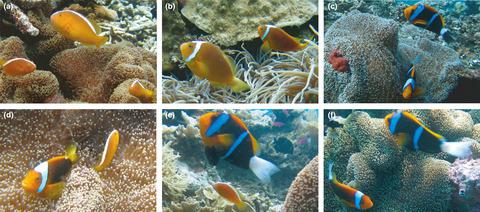当前位置:
X-MOL 学术
›
Ecol. Evol.
›
论文详情
Our official English website, www.x-mol.net, welcomes your
feedback! (Note: you will need to create a separate account there.)
Species integrity, introgression, and genetic variation across a coral reef fish hybrid zone
Ecology and Evolution ( IF 2.3 ) Pub Date : 2020-10-21 , DOI: 10.1002/ece3.6769 Ashton Gainsford 1, 2 , Geoffrey P Jones 1, 2 , Jean-Paul A Hobbs 3 , Franz Maximilian Heindler 4 , Lynne van Herwerden 2
Ecology and Evolution ( IF 2.3 ) Pub Date : 2020-10-21 , DOI: 10.1002/ece3.6769 Ashton Gainsford 1, 2 , Geoffrey P Jones 1, 2 , Jean-Paul A Hobbs 3 , Franz Maximilian Heindler 4 , Lynne van Herwerden 2
Affiliation

|
Hybridization and introgression are evolutionarily significant phenomena breaking down species boundaries. “Hybrid zones” (regions of species overlap and hybridization) enable quantification of hybridization frequency and examination of mechanisms driving and maintaining gene flow. The hybrid anemonefish Amphiprion leucokranos is found where parent species (A. chrysopterus; A. sandaracinos) distributions overlap. Here, we examine geographic variation in hybridization and introgression, and potential impacts on parent species integrity through assessing relative abundance, social group composition, and genetic structure (mtDNA cytochrome b, 21 microsatellite loci) of taxa at three hybrid zone locations: Kimbe Bay (KB) and Kavieng (KA), Papua New Guinea; the Solomon Islands (SO). Relative abundances of and size disparities between parent species apparently drive hybridization frequency, introgression patterns, and genetic composition of taxa. Conspecific groups are most common in KB (65%) where parent species are similarly abundant. Conversely, mixed species groups dominate SO (82%), where A. chrysopterus is more abundant. Hybrids most commonly cohabit with A. sandaracinos in KB (17%), but with A. chrysopterus in KA (22%) and SO (50%). Genetic differentiation (nDNA) analyses indicate that parent species remain distinct, despite ongoing hybridization and hybrids are genetically similar to A. sandaracinos—resulting from persistent backcrossing with this smallest species. This study shows that hybridization outcomes may depend on the social and ecological context in which taxa hybridize, where relative abundance and disparate size of parent species explain the frequency and patterns of hybridization and introgression in the A. leucokranos hybrid zone, reflecting size‐based dominance behaviors of anemonefish social groups.
中文翻译:

珊瑚礁鱼类杂交区的物种完整性、基因渗入和遗传变异
杂交和基因渗入是打破物种界限的、具有重要进化意义的现象。 “杂交区”(物种重叠和杂交的区域)可以量化杂交频率并检查驱动和维持基因流的机制。杂交海葵鱼Amphiprion leucokranos被发现于亲本物种( A. chrysopterus;A. sandaracinos )分布重叠的地方。在这里,我们通过评估三个杂交区位置的类群的相对丰度、社会群体组成和遗传结构(mtDNA细胞色素b ,21个微卫星位点)来检查杂交和基因渗入的地理变异,以及对亲本物种完整性的潜在影响:金贝湾( KB) 和卡维恩 (KA),巴布亚新几内亚;所罗门群岛 (SO)。亲本物种之间的相对丰度和大小差异显然会影响类群的杂交频率、基因渗入模式和遗传组成。同种群体在 KB 中最常见 (65%),其亲本物种也同样丰富。相反,混合物种群体在 SO 中占主导地位 (82%),其中A. chrysopterus更为丰富。杂交种最常与 KB (17%) 中的A. sandaracinos共生,但与 KA (22%) 和 SO (50%) 中的A. chrysopterus共生。遗传分化(nDNA)分析表明,尽管正在进行杂交,但亲本物种仍然不同,并且杂种在遗传上与山达拉西诺(A. sandaracinos)相似 - 这是与这种最小物种持续回交的结果。 这项研究表明,杂交结果可能取决于类群杂交的社会和生态环境,其中亲本物种的相对丰度和不同的大小解释了A. leucokranos杂交区杂交和渗入的频率和模式,反映了基于大小的优势小丑鱼社会群体的行为。
更新日期:2020-11-13
中文翻译:

珊瑚礁鱼类杂交区的物种完整性、基因渗入和遗传变异
杂交和基因渗入是打破物种界限的、具有重要进化意义的现象。 “杂交区”(物种重叠和杂交的区域)可以量化杂交频率并检查驱动和维持基因流的机制。杂交海葵鱼Amphiprion leucokranos被发现于亲本物种( A. chrysopterus;A. sandaracinos )分布重叠的地方。在这里,我们通过评估三个杂交区位置的类群的相对丰度、社会群体组成和遗传结构(mtDNA细胞色素b ,21个微卫星位点)来检查杂交和基因渗入的地理变异,以及对亲本物种完整性的潜在影响:金贝湾( KB) 和卡维恩 (KA),巴布亚新几内亚;所罗门群岛 (SO)。亲本物种之间的相对丰度和大小差异显然会影响类群的杂交频率、基因渗入模式和遗传组成。同种群体在 KB 中最常见 (65%),其亲本物种也同样丰富。相反,混合物种群体在 SO 中占主导地位 (82%),其中A. chrysopterus更为丰富。杂交种最常与 KB (17%) 中的A. sandaracinos共生,但与 KA (22%) 和 SO (50%) 中的A. chrysopterus共生。遗传分化(nDNA)分析表明,尽管正在进行杂交,但亲本物种仍然不同,并且杂种在遗传上与山达拉西诺(A. sandaracinos)相似 - 这是与这种最小物种持续回交的结果。 这项研究表明,杂交结果可能取决于类群杂交的社会和生态环境,其中亲本物种的相对丰度和不同的大小解释了A. leucokranos杂交区杂交和渗入的频率和模式,反映了基于大小的优势小丑鱼社会群体的行为。











































 京公网安备 11010802027423号
京公网安备 11010802027423号